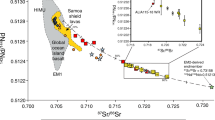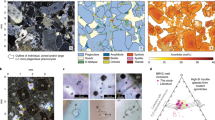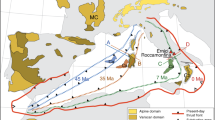Abstract
Microdiorite enclaves are arguably the most poorly understood of the more prominent features of granitoids. Surprisingly, they have been invoked as support for completely different models for the origin of chemical zonation in granitoids, depending on whether they are interpreted as restites, syn-plutonic blobs of magma, remobilized cumulate or basified country-rock xenoliths. Here we present the first detailed neodymium and strontium isotope study of suites of such enclaves from two plutons. In both cases we find relatively high σNd values, most readily explained if enclaves represent syn-plutonic injections of mafic magma into the host granitoid magma. As such they are the tangible remains of a very important process of mantle-derived heat and mass transfer operating in the generation of granitic magmas.
This is a preview of subscription content, access via your institution
Access options
Subscribe to this journal
Receive 51 print issues and online access
$199.00 per year
only $3.90 per issue
Buy this article
- Purchase on Springer Link
- Instant access to full article PDF
Prices may be subject to local taxes which are calculated during checkout
Similar content being viewed by others
References
1. Didier, J. Granites and Their Enclaves (Elsevier, Amsterdam, 1983). 2. Cantagrel, J. M., Didier, J. & Gourgoug, A. Phys. Earth planet. Interiors 35, 63-76 (1984). 3. Vernon, R. H. Nature 309, 438-439 (1984); / Proc. R. Soc. NSW 116, 77-103 (1983). 4. Reid, J. B., Evans, O. C. & Fates, D. C. Earth planet. Sci. Lett. 66, 243-261 (1983). 5. Pabst, A. Univ. Calif. Publ. Geol. Sci. 17, 325-386 (1928). 6. Grout, F. F. Bull Geol Soc. Am. 48, 1521-1572 (1937). 7. Ferstata, G. B. & Borodina, N. S. Inst. Geol. Rev. 19, 458-468 (1977). 8. White, A. J. R. & Chappell, B. W. Tectonophysics 43, 7-22 (1977). 9. Chappell, B. W. Phil. Trans. R. Soc. A310, 693-707 (1984). 10. Compston, W. & Chappell, B. W. in The Earth: Its Origin, Structure and Evolution (ed. McElhinny, M. W.) 377-426 (Academic, London, 1979). 11. McCulloch, M. T. & Chappell, B. W. Earth planet. Sci. Lett. 58, 51-58 (1982). 12. Whalen, J. B. J. Petrol. 26, 603-632 (1985). 13. Bender, J. F., Hanson, G. N. & Bence, A. E. Earth planet. Sci. Lett. 58, 330-344 (1982). 14. Oxburgh, E. R. & McRae, T. Phil. Trans. R. Soc. A310, 457-472 (1984). 15. Sparks, R. S. J., Siguardson, H. & Wilson, L. Earth planet. Sci. Lett. 35, 234-238 (1977). 16. Spera, F. J. in Physics ofMagmatic Processes (ed. Hargreaves, R. B.) (Princeton University Press, 1980). 17. Eichelberger, J. C. Nature 275, 21-27 (1978); 288, 446-450 (1980). 18. Grey, C. M. Earth planet. Sci. Lett. 70, 47-60 (1984). 19. Domenick, M. A., Kistler, R. W., Dodge, F. C. W. & Tatsumoto, M. Bull. Geol. Soc. Am. 94,713-719(1983). 20. Hildreth, W. /. geophys. Res. 86, 10153-10192 (1981). 21. Halliday, A. N. Nature 307, 229-233 (1984). 22. Halliday, A. N., Stephens, W. E. & Harmon, R. S. /. Geol. Soc. 137, 329-348 (1980). 23. Halliday, A. N. & Stephens, W. E. Phys. Earth planet. Interiors 35, 89-109 (1984). 24. Stephens, W. E. & Halliday, A. N. Phil. Trans. R. Soc., Edin. 75, 259-273 (1984). 25. Harmon, R. S., Halliday, A. N., Clayburn, J. A. P. & Stephens, W. E. Phil. Trans. R. Soc. A310, 709-742 (1984). 26. Thirwall, M. T. Earth planet. Sci. Lett. 58, 27-50 (1982). 27. Pidgeon, R. T. & Aftalion, M. Geol. J. 10, 183-220 (1979). 28. Sabine, P. A. Bull. geol. Surv. 20, 6-42 (1962). 29. MacGregor, A. G. & Kennedy, W. Q. Sum. Proc. Geol. Surv. (1931) 105 (1932). 30. Phillips, W. J. J. geol. Soc. 112, 221-240 (1956). 31. Phillips, W. J., Fuge, R. & Phillips, N. /. geol. Soc. 138, 351-366 (1981). 32. Vance, J. A. Am. J. Sci. 260, 746-760 (1962). 33. Hibbard, M. J. Contrib. Miner. Petrol. 90,1047-1062 (1979); Geol. Soc. Am. Bull. 76,158-170 (1981). 34. Wyllie, P. J., Cox, K. G. & Biggar, G. M. / Petrol. 3, 238-242 (1962). 35. Halliday, A. N., Aftalion, M., van Breemen, O. & Jocelyn, J. in Caledonides of the British Isles Reviewed (eds Harris, A. L., Holland, C. H. & Leake, B. E.) 653-661 (Scottish Academic Press, 1979). 36. Halliday, A. N. in Melting Migmatites and Metamorphism, 54-61 (Shiva, Nantwich, 1983). 37. Hamilton, P. J., O'Nions, R. K. & Pankhurst, R. J. Nature 287, 279-284 (1980). 38. Pankhurst, R. J. in Origin of Granite Batholiths, 18-33 (Shiva, Nantwich, 1979). 39. Stephens, W. E. & Halliday, A. N. Bull. geol. Soc. Am. 91, 165-170 (1980). 40. Halliday, A. N. et al. Scott. J. Geol. 21, 465-491 (1985). 41. Halliday, A. N., Menzies, M. A., Palacz, Z., Hunter, R. H. & Hawkesworth, C. J. Trans. Am. geophys. Un. 66, 414 (1985). 42. Menzies, M. A. & Halliday, A. N. Trans. R. Soc. Edin.: Earth Sci. 75, 298-299 (1984); 27th Int. Geol. Congr. Abstr. 5, 348 (1984). 43. Margaritz, M. & Hofmann, A. W. Geochim. cosmochim. Acta 42, 595-605 (1978). 44. Margaritz, M. & Hofmann, A. W. Geochim. cosmochim. Acta 42, 847-858 (1978). 45. Frost, C. D. & O'Nions, R. K. J. Petrol. 26, 515-544 (1985). 46. O'Nions, R. K., Hamilton, P. J. & Hooker, P. J. Earth planet. Sci. Lett. 63, 229-240 (1983). 47. Farmer, G. L. & DePaolo, D. J. / geophys. Res. 88, 3379-3401 (1982). 48. Hamilton, P. J., Evenson, N. M., O'Nions, R. K. & Tarney, J. Nature 277, 25-28 (1979). 49. Jacobson, S. B. & Wasserburg, G. J. J. geophys. Res. 84, 7249-7445 (1979).
Author information
Authors and Affiliations
Rights and permissions
About this article
Cite this article
Holden, P., Halliday, A. & Stephens, W. Neodymium and strontium isotope content of microdiorite enclaves points to mantle input to granitoid production. Nature 330, 53–56 (1987). https://doi.org/10.1038/330053a0
Received:
Accepted:
Issue Date:
DOI: https://doi.org/10.1038/330053a0
This article is cited by
-
The pristine precursor of Andean-type magmatism preserved in magma mingling zones
Scientific Reports (2024)
-
Early Cretaceous granitoids and gabbro in the Liaodong Peninsula: implications for delamination of the North China Craton and Paleo-Pacific Plate subduction
Mineralogy and Petrology (2021)
-
Causal relationship between mafic magma underplating and migmatization of arc crust: Evidence from the Madras block of Southern Granulite terrane, India
Journal of Earth System Science (2021)
-
The Late Ordovician granitoids in the East Kunlun Orogenic Belt, Northwestern China: petrogenesis and constraints for tectonic evolution of the Proto-Tethys Ocean
International Journal of Earth Sciences (2020)
-
Ambiguous isotopic and geochemical signatures resulting from limited melt interactions in a seemingly composite pluton: a case study from the Strzegom–Sobótka Massif (Sudetes, Poland)
International Journal of Earth Sciences (2019)
Comments
By submitting a comment you agree to abide by our Terms and Community Guidelines. If you find something abusive or that does not comply with our terms or guidelines please flag it as inappropriate.



